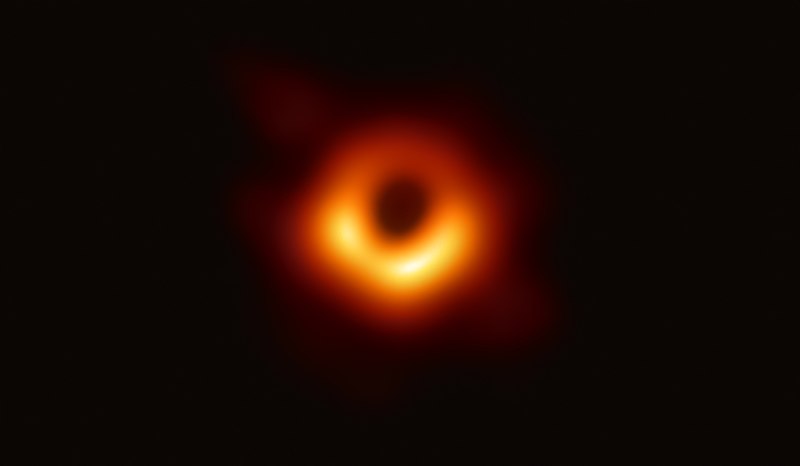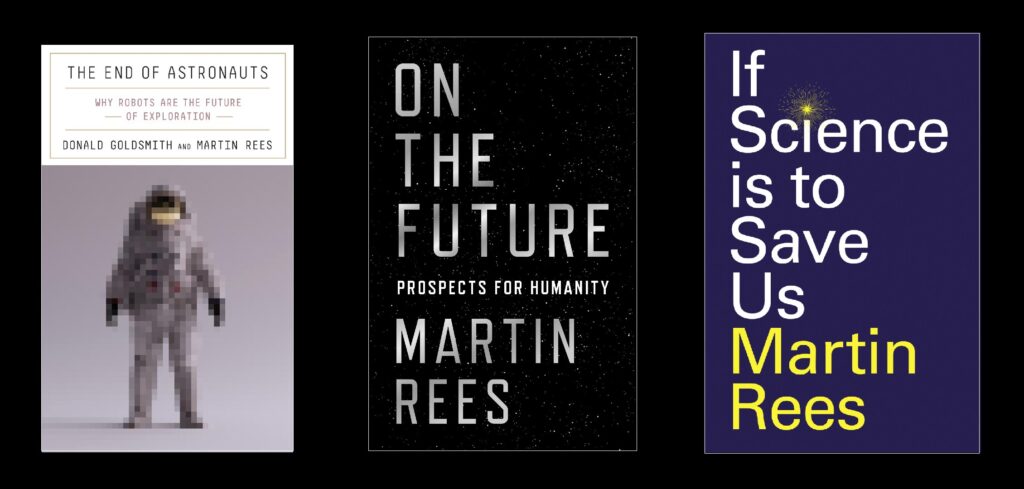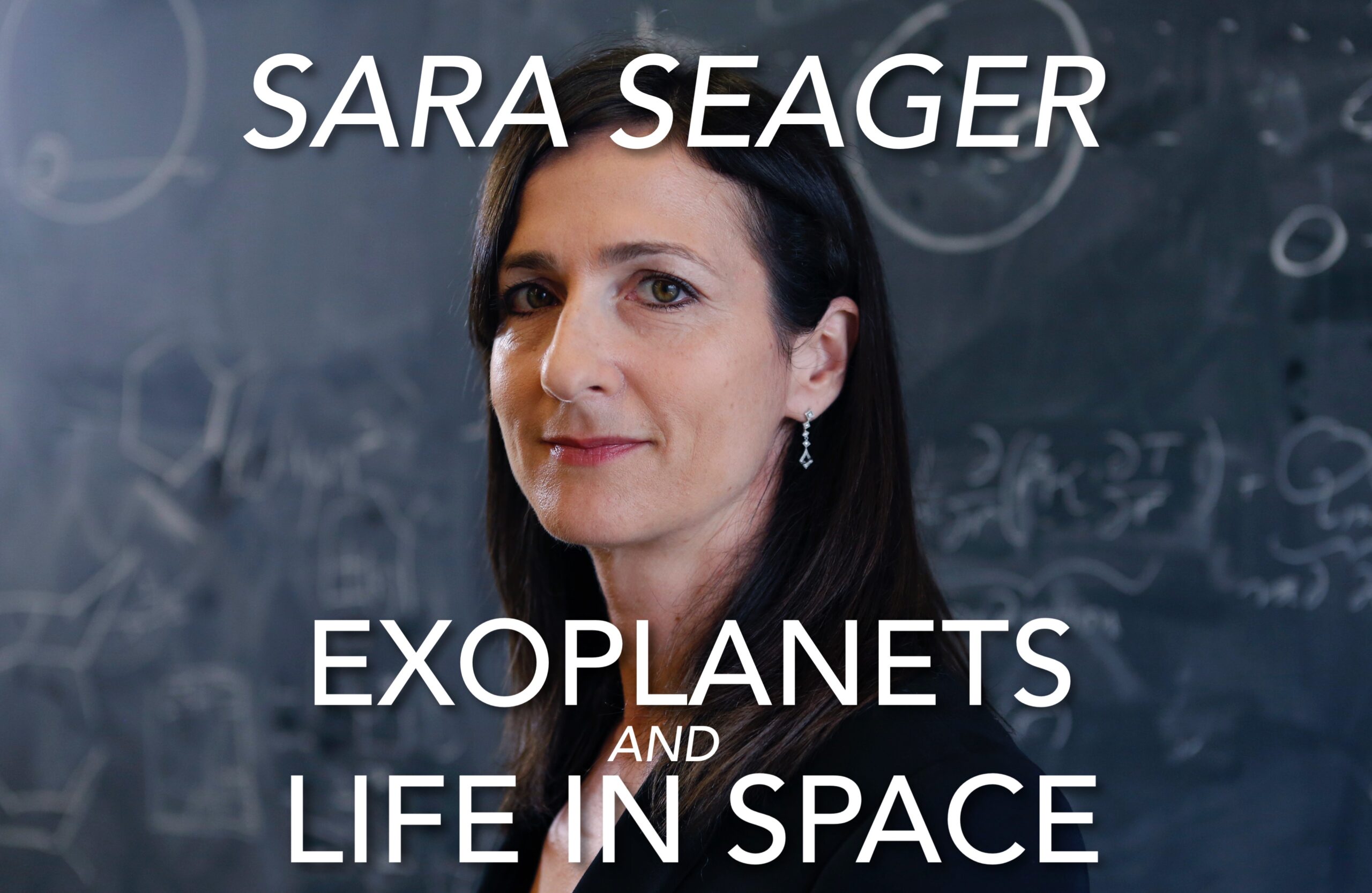This interview was conducted in October 2022 and has been edited for brevity and clarity.
About Martin Rees
Martin Rees is a renowned astrophysicist and cosmologist. He is currently a professor at the University of Cambridge and a fellow of Trinity College. Rees has made significant contributions to the fields of cosmology and black hole physics, and is known for his work on the nature of quasars, galaxy formation, and the structure of the Universe. He has also written several popular science books, including On the Future (2018) and If Science is to Save Us (2022). Rees has received numerous awards and honors for his work, including the Templeton Prize in 2011. He was was President of the Royal Society during 2005-2010.
Black holes and quasars
What are the most fascinating scientific discoveries during your career?
– In the mid-1960s, as a graduate student, I entered a field that was incredibly exciting. It was a time when the first evidence for the Big Bang, black holes, and neutron stars emerged. I always tell students that they should choose a field where new things are happening, with new observations, ideas, and techniques. This way, they have the chance to do something for the first time, without being bogged down by problems that previous generations couldn’t solve. I was fortunate enough to be a part of that exciting time and even write some of the early papers on those topics. However, the past years have been just as exciting, with the discovery of gravitational waves and advancements in astrobiology, including the search for exoplanets.

Martin Rees studied at the Cambridge University Trinity College
Was black holes the topic that got you the most excited in the beginning of your career?
– I consider myself a phenomenologist, as my focus has been on making sense of the various new phenomena that have emerged in my field. One of the most intriguing discoveries at the time was that of quasars, which are extremely distant objects that are outshining all the stars in their host galaxy by a factor of up to 100. These objects were difficult to interpret. Some of them were also emitting strong radio waves, so a significant portion of my early work was dedicated to understanding how they produced such high levels of radio emission. It became clear over the next decade that the energy source for these quasars was a massive black hole located in the centre of the galaxy. The black hole captures gas, which is then pulled into the centre and becomes magnetized, releasing energy that lights up the surrounding gas and produces more light than all the stars in the galaxy combined.
– There are two general themes in my field of study. The first is to understand extreme objects and materials under conditions that are more extreme than what can be created in a lab. This is particularly important when it comes to understanding places where gravity is strong, such as black holes, and sources of extremely high-energy radiation, like gamma ray bursts, which I have studied for the past 30 years. The other theme is to understand the big picture, such as how the first stars and galaxies formed and evolved, from the dense beginning of the Universe. With new telescopes, we can now observe more than 95% of cosmic history by looking at distant galaxies, which provides us with even more evidence of cosmic evolution.
“As a taxpayer, I believe that money should not be spent on human space flights.”
In 2019, the first ever image of a black hole was published. How did you react when it came out?
– Well, I was not surprised. It was a crude representation of what we had expected. However, it was a significant technical achievement as the team was able to link together data from eight different telescopes around the world to obtain the image. It required heavy processing, so it was a great achievement in terms of technical expertise.

The first direct visual evidence of the supermassive black hole in the centre of galaxy Messier 87, by The Event Horizon Telescope (EHT).
Inspire future scientists
Even though experts may not have been surprised by the image, it generated a lot of public interest and discussion. Doesn’t this level of public engagement also represent a significant success, as it can inspire future generations of scientists and engineers, similar to the impact of the moon landing on scientific and technological fields for many years to come?
– I agree with you, the image of the black hole did make the front page of many newspapers, and it’s clear that it captured the public’s attention. When it comes to the moon landing, I recently published a book called The End of Astronauts (2022) in which I explore the question of how important it is for people to go into space. As technology, such as robots and AI, continue to improve, the practical need to send people into space to assemble structures or explore places like the moon or Mars is becoming weaker. As a taxpayer, I believe that money should not be spent on human space flights. If NASA were to pursue this, it would be extremely expensive due to their safety requirements. While astronauts can be heroes, I believe that funding for human space flight should be left to billionaires and other sponsors who are willing to accept the high risks that NASA would not be able to impose on publicly funded civilians. So, I see the future of human space flight as being high-risk adventures, funded by private individuals or entities.
Brian Greene said that when kids look up to great scientists the way they do to great musicians and actors, civilization will jump to the next level. How can we spark that curiosity in the younger generation?
– One approach is to improve teaching methods. Most young children are fascinated by dinosaurs and space, which are not directly relevant to their lives. But that enthusiasm should be nurtured and built upon. In many countries, including the United Kingdom, science education at the secondary school level is not always inspiring, which can cause students to lose interest. Additionally, we have a system where students are required to specialize at the age of 16, which can lead to many turning away from science for good.

Three books by Martin Rees: The End of Astronauts (2022), On the Future (2011) and If Science is to Save Us (2022).
– However, it is important to maintain that enthusiasm for science, as more and more decisions in a democracy have a scientific dimension. To have a meaningful public debate, it is necessary for everyone to have at least a basic understanding of science, so they are not easily misled by bad statistics. To motivate people to gain an understanding, high-profile events such as human space flight are undoubtedly helpful. The pandemic also showed science at its best. In my country, the top government scientist in the field was regularly on television and the public came to understand that early on there were a lot of uncertainties, such as whether or not it was helpful to wear masks, and those were gradually clarified. Furthermore, the achievement of producing vaccines within a year, through the collaboration between academia and pharmaceutical companies, showed science at its best and the public were able to understand it.
Yes, maybe this will lead to a whole new generation of highly motivated biomedical experts and epidemiologists, we’ll see! When you lay out the case against publicly funded human space flight, have you included the consideration of how astronauts serve as inspiration for the next generation of scientists?
– I would cheer on the millionaires if they were funding space missions, particularly if the goal is to go to Mars. Sending robots to Mars is relatively easy, as they can hibernate for six months, and they can even go to the outer planets. However, sending humans to Mars is significantly harder than sending them to the Moon and it is difficult to justify the cost. If we want to inspire the public, I believe it should be through people who accept high risks, such as one-way trips, similar to how explorers who went to the South Pole a century ago were admired. This can be done through private funding and by taking individuals who are willing to accept the risks.
“Many key questions still remain to be answered, like why the Universe is expanding the way it is and why it contains a mix of atoms, dark matter and radiation.”
Do you support the initiative of building a base on the Moon?
– I support the idea of building a telescope on the far side of the Moon, away from radio interference, and potentially a few other projects that can be assembled by robots using new robotic techniques. I don’t see a compelling need for humans to be involved in these types of missions. However, if it is feasible, the private sector may be willing to fund such projects.
The mysteries of the Universe
What are the next big questions about black holes that we want to find answers to?
– I think black holes are probably the most spectacular confirmation of Einstein’s theory of gravity. Everyone accepts that it’s a wonderful theory and it has been corroborated by the gravitational waves. However, one would like to have a theory that incorporates gravity and the quantum principle in a single concept. This might be necessary in order to understand what happens in the center of a black hole, the so-called singularity, and also relevant to the very early stages of the Big Bang.

Martin Rees together with theoretical physicist Freeman Dyson (1923 – 2020) in 2007.
– The Big Bang theory has very strong support. I believe we can now talk about what happened in the Universe after the first microsecond up until the present, with the same level of confidence as a geologist can talk about the early history of the Earth. This is because the physics that we can achieve in an accelerator is understood. We also have fossils from the first two seconds, the proportions of hydrogen, helium and deuterium, which agrees with the theory. And then we have the fluctuations which are telling us about the Universe when it was 300,000 years old. They have the properties which under gravity lead to clustering and the forming of galaxies that we see today. So we have good links between the very early Universe and the present Universe. It’s a well-supported theory.
– Many key questions still remain to be answered, like why the Universe is expanding the way it is and why it contains a mix of atoms, dark matter and radiation. But those questions can’t be answered without probing back into the first microsecond after the Big Bang. Of course, the conditions then were even hotter and denser so every particle had higher energy than we can produce in an accelerator. That’s where the exotic physics come in, and we all suspect that to understand those questions, a big leap will be required.
“In the realm of quantum physics, things can be counter-intuitive and even more so when considering remote, extreme conditions such as those present before the Big Bang.”
Does it make sense to ask what happened before the Big Bang, or is that like asking what’s north of the North pole?
– It is a valid question but the answer may not be straightforward. It depends on the theory being considered. In the realm of quantum physics, things can be counter-intuitive and even more so when considering remote, extreme conditions such as those present before the Big Bang. Our intuition may not be able to grasp the concepts of time and space in these contexts, as they may become blurred and involve additional dimensions.
– Many theories propose that physical reality is far more extensive than the observable Universe, and that beyond the horizon of our telescopes there are many galaxies that we will never see. These galaxies may be the aftermath of our Big Bang, or perhaps other Big Bangs. While we don’t yet know for sure, it is likely that physical reality is much more extensive than we currently understand. Whether these other realities existed before or alongside ours remains to be seen.
Working in the field that you do, with the vast Universe and the incomprehensible time spans, do you ever feel small in an uncomfortable way?
– I believe that complexity, not size, is what makes things interesting. I often say that the smallest organism is more complex than a star. However, being an astronomer does give one a unique perspective, specifically in the awareness of the far future. Many might understand the outcome of nearly four billion years of evolution, but may think that humans are the culmination of this process. As astronomers, we know that the sun, which is 4.5 billion years old, has six billion years left before it runs out of fuel. We also know that the Universe has a vastly longer future ahead of it. This leads us to believe that even more wonderful and complex structures beyond humans may manifest in the far future. It may not be biological evolution, but it could be electronic or something else. This awareness of large spans of time in the future, and not just in the past, and the understanding that we may not even be at the halfway stage in the emergence of complexity, is a unique perspective that astronomers have.

Observatory of SETI – Search for Extraterrestrial Intelligence.
Extraterrestrial life and Astrobiology
Let’s talk Astrobiology. If we do find extraterrestrial life, what do you think it would look like?
– It’s hard to say since I’m not a biologist, and the truth is that we don’t even fully understand how life began on Earth. We understand evolution, but the transition from chemistry to the first metabolizing, reproducing organism that we say is alive, is still a mystery. Even the most earthbound biologists realize this. In the past, the idea was dismissed as too difficult, but now more and more people are working on it. The motivation is not just new ideas from biochemists, but also the awareness that we may soon learn whether there is anything organic on other places in our solar system, such as the moons of Jupiter, and of course, on the many millions of Earth-like planets that we now know exist in our galaxy.
– It has made the question of whether life is a rare fluke or something that routinely happens in any environment, a lot more interesting. The question of whether it would be something like the double helix or quite different, is intriguing. Could it have something else than a water base? Could there be life in an environment like Titan, the moon of Saturn, where there are lakes of liquid methane? We don’t know. But that’s why it’s so fascinating to look for any evidence of life of any kind. Exploration of the outer planets by robots is going to be important, as well as developing even better telescopes with the ability to indicate evidence for biological activity of some kind on exoplanets.

Picture of the moon Titan in front of Saturn. Credits: NASA/JPL-Caltech/Space Science Institute
– I believe that the search for life elsewhere in our solar system is a worthwhile and exciting endeavor. The possibility of finding life under the ice on Enceladus or Europa, the moons of Saturn and Jupiter respectively, would provide evidence of two independent origins of life within our solar system. This would suggest that life is not a rare accident and may exist in countless places throughout our galaxy. The James Webb Space Telescope and the Extremely Large Telescope being built in Chile will have the capability to collect enough light to obtain crude spectra of near Earth-like planets orbiting other stars, potentially indicating the presence of vegetation or other signs of life.
– We have to consider that if intelligent life exists elsewhere in the Universe, it may have evolved differently than humans have. It’s possible that they may have passed the stage of organic civilization and evolved into something electronic, which would have different characteristics and behaviors. The Drake equation, which calculates the probability of the existence of extraterrestrial life, has a factor for the duration of a civilization. The typical assumption is that a civilization lasts for only a few hundred years, but if we consider the billions of years in the past and future, it’s more likely that we would detect something electronic from a planet that has had a head start in evolution.
“We may be like a biologist trying to infer what’s in the ocean by analysing just one bucket of water.”
– The Fermi Paradox, which asks why we haven’t yet found evidence of extraterrestrial life, may be explained by the fact that Darwinian evolution favors intelligence and aggression. However, future evolution may take a different path, with machines designing better machines, which may favor greater intelligence but not necessarily aggression. As a result, these electronic entities may not reveal themselves or want to expand their territory. It’s important to keep an open mind on what might be out there and to look for any evidence of extraterrestrial life, as there is currently no strong evidence against its existence.
If we would come across intelligent life, what effects do you think it would have on us? How would people react? Would it spark a global panic?
– I think people would find it rather interesting!
A fascinating hypothetical thought is what aliens, who might be observing us, would identify as the main form of life on Earth. Would it be the trees and plants that cover such big parts of our planet, or maybe they would identify the cities as huge organisms? What do you think?
– Well, again I think it’s important to approach these fundamental mysteries with an open mind. It’s possible that there may be aspects of reality that our current understanding and our human brains simply cannot comprehend. It’s similar to how a monkey is unable to grasp quantum theory. We may think we understand certain concepts, such as the chemistry behind the origin of life and the mechanics of black holes, but there could be unknown and undiscovered mysteries that we are not currently aware of. We should be mindful that “physical reality” could be vastly more extensive and complex than the volume of space that astronomers can observe. We may be like a biologist trying to infer what’s in the ocean by analysing just one bucket of water.
What book would you like to recommend?
– The sci-fi books of Olaf Stapledon, a British author who started writing in the 1930s. There’s one called Last and First Men (1930), that describes the history of humanity from the present onwards across two billion years. Another one is called Star Maker (1937). It’s a fascinating book, because Stepledon thought about a “multiverse”, which is one of my own enthusiasms, though still a speculation. He wrote about Universes with different numbers of dimensions, for instance a musical Universe which has only one spatial dimension and time! Wonderful ideas. He was very original.
If you liked this article, you should probably also check these out:

